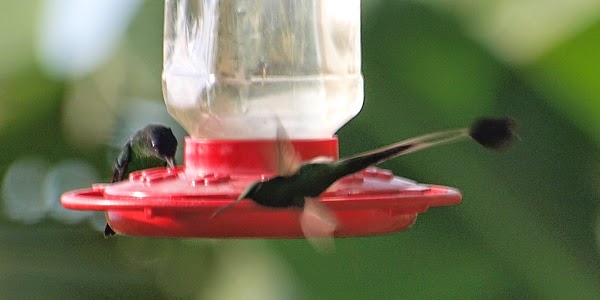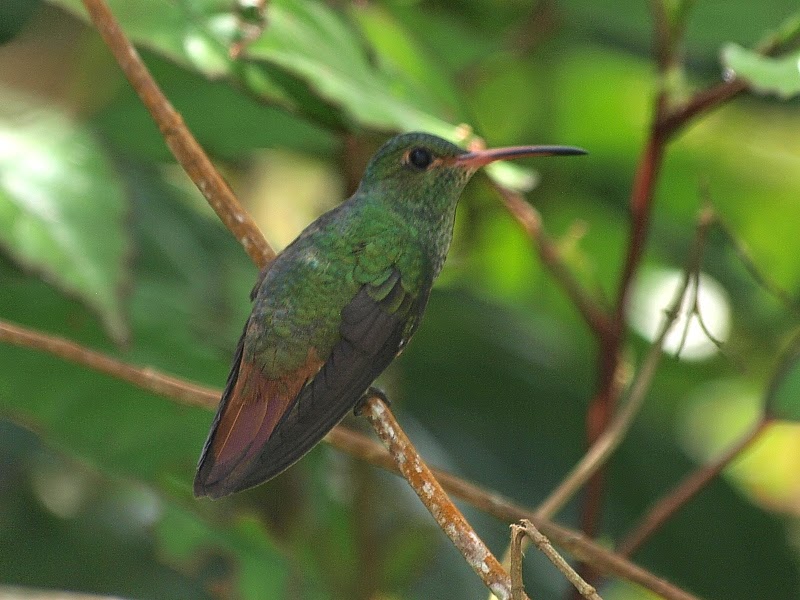 |
| Wedge-billed Hummingbird |
 |
| Red Howler Monkey |
 |
| White-capped Dipper, a firm favourite of mine |
 |
| Torrent Tyrannulet |
 |
| Southern Lapwing, not quite as impressive as ours |
 |
| Saffron Finch |
 |
| hillside near Bucaramanga |
 |
| Bare-faced Ibis |
 |
| Common Tody-Flycatcher at our breakfast stop |
 | ||
| Bananaquit keeping an eye on hummers stacking up to land, in this case female Black-throated Mango and Andean Emerald |
 |
| Bananaquit, regular on the feeders too |
 |
| Rufous-tailed Hummingbird, perhaps the commonest hummer around the lodge |
 |
| they seemed to spend as much time chasing each other as feeding |
 |
| even at a shutter speed of 1/400th second the wings are blurred |
 |
| at 1/250th second they are hardly visible |
 |
| not the most spectacular of hummers, but sill nice |
 |
| male Black-throated Mango |
 |
| female Black-throated Mango, much more distinctive |
 |
| Green Hermit |
 |
| Green-crowned Brilliant, another common visitor to the lodge feeders, is one is a female |
 |
| male Green-crowned Brilliant, unfortunately not catching the light |
 |
| male Booted Racket-tail |
 |
| in for a quick refuel ... |
 |
| ... and it is off! |
 |
| male Violet-crowned Woodnymph |
 |
| nice when it catches the light |
 |
| White-necked Jacobin |
 |
| few are as easy to identify even if the white neck isn't always apparent |
 |
| White-necked Jacobin and Andean Emerald |
 |
| Andean Emerald, another of the commoner visitors to the lodge's feeders |
 |
| even the duller female has a very nice rainbow effect from crown to tail |
 |
| Brown Violetear and Indigo-capped Hummingbird |
 |
| Indigo-capped Hummingbird |
 |
| well nourished toad by the lodge |
 |
| climbing above Cerulea Lodge |
 |
| looking down from the forest edge at the Cerulea reserve |
 |
| Ochre-breasted Antpitta |
 |
 |
| disturbed from beside the trail, it just sat and looked at me |
 | ||
| the ProAves Cerulean Warbler forest reserve, we were too early for returning Cerulean Warblers |
 |
| view from forest reserve entrance |
 |
| American Kestrel |
 |
| Bicoloured Wren near the lodge |
 |
| Green Hermit |
 |
| Black-throated Mango female |
 |
| Black-throated Mango male |
 |
| Green-crowned Brilliant female |
 |
| Green-crowned Brilliant male |
 |
| flashing his shiny bits |
 |
 |
| Andean Emerald |
 |
| Indigo-capped Hummingbird |
 |
| White-necked Jacobin male |
 |
| showing its named feature |
 |
| this one's feathers looked a bit the worse for wear |
 |
| White-necked Jacobin female |
 |
| Rufous-tailed Hummingbird |
 |
 |
| the tiny feet of hummingbirds always amaze me |
 |
| Yellow-tailed Oriole. The outer tail feathers are yellow but often held below the inner ones |
 |
| as can be seen in his image |
 |
| Rufous-tailed Jacamar |
 |
| Bucaramanga from the airport |
 |
 |
| another big city few outside of Colombia would have heard of |
 |
| Bicoloured Wren in the open-air cafe at Bucaramanga Airport |
 |
| White-chinned Thistletail |
 |
 |
 |
| Bioandina |
 |
| superb forest that doubtless deserved longer than our unproductive flying visit |
 |
| me (and Nick) well behind the group, as usual |
 |
| Coppery-bellied Puffleg (poorly digiscoped) |
 |
| birding further down the road |
 |
| panoramic view from below Bioandina |
 |
| female Green & Black Fruiteater |
26 July 2014. Four of us left the Hotel Ibis with Alejandro at 04:45 heading for Monterredondo, the only accessible site for Cundinamarca Antpitta. We stopped for a roadside breakfast as it was getting light, a miserable morning with hanging low cloud. We turned off the main road and started climbing and after a few kms entered the forest. Our driver knew the site and stopped on a bend indicating to look along the sections immediately above and below where we were parked. We knew the antpitta would be difficult as it was suggested that they had become tape shy. Nick had also failed on his previous visit which was not a good sign. We spent most of the morning along this small section of road and twice got a brief response to to tape playback. Both times we went in but to no avail. We saw a few nice birds including Amythyst-throated Sunangel, Andean Pygmy Owl (responded to Alejandro's whistling), Crimson-mantled Woodpecker, Rufous Antpitta, Rufous-headed Pygmy-Tyrant and Grass-green and Golden-crowned Tanagers (the latter one of the best I've seen). My only chance of a new bird was looking like Green-bellied Hummingbird which Alejandro said we'd look for in some flowering trees on the way down. We left Monterredondo at 13:30 as it started to rain, and before I knew it were back in town for lunch. I asked Alejandro where the hummingbird site was and was told we had not stopped there as it was raining and hummingbirds would not be active. That seemed nonsense to me as my experience, albeit at feeders, was that hummers go bananas when it rains. That had certainly been the case at Rio Blanco. Even if it was true it would have been worth checking the tree in case a hummer was sitting nearby. I concluded that Alejandro either did not know where the site was, did not like getting wet or was more concerned not to have a late lunch. Each alternative was deeply unsatisfactory and reinforced my previous view of him. We were back at the Hotel Ibis soon after 16:00 after another very unsatisfactory part-day in the field. Both Nick and I had several words with Pablo several times about how disappointed we were with this part of the trip. After an absolutely brilliant start at Rio Blanco and some excellent hummingbird feeders the first week had deteriorated into a considerable disappointment with the sites deserving twice as long as we had given them, although a full day at Monterredondo might have sufficed.
 |
| Monterredondo |
 |
| birding the road at Monterredondo, me then Nick bringing up the rear |
 |
| Andean Pygmy Owl |
 |
| the only owl seen all trip which for a four week terrestrial birding tour is, in my mind, fairly scandalous |











